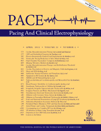Radiofrequency Ablation Does Not Induce Apoptosis in the Rat Myocardium
Financial support: Research supported by FAPESP, Fundação de Amparo à Pesquisa do Estado de São Paulo (LFS and GF).
Abstract
Background: The mechanisms implicated in the genesis of delayed radiofrequency (RF) effects remain unclear, but may be related to extension of the lesion beyond the region of coagulative necrosis. The role of apoptosis in this process has not been previously reported. We assessed whether RF promotes apoptosis in the region surrounding acute ablation lesions in a rat model.
Methods: Wistar rats (n = 30; weight 300 g) were anesthesized, the chest was opened, and the heart was exposed. A modified unipolar RF ablation (custom catheter 4.5-mm-tip diameter, 12 Watts, 10 seconds) was undertaken on the left ventricular anterolateral epicardial surface and the chest was closed. After 2 hours, animals were killed for histological (hematoxylin and eosin, TdT-mediated dUTP Nick End-Labeling [TUNEL] assay) and immunohistochemical (anti-BAD and anti-caspase 3 antibodies) analysis (n = 18). Additional animals (n = 12) were sacrificed at 2 (n = 3), 24 (n = 3), 48 (n = 3), and 72 hours (n = 3) after ablation exclusively for anti-BAD Western Blotting analysis.
Results: Lesions were characterized by well-defined regions of coagulative necrosis. In 18/18 (100%) animals, TUNEL assay revealed positive luminescent reaction cells in the region surrounding the lesion, extending up to 2 mm from the border zone. However, microscopic evaluation of the nuclei and immunohistochemical and anti-BAD Western Blotting analysis were negative in all (100%) rats. Thus, positive TUNEL reaction in the periphery of the ablation lesion likely reflects nonspecific DNA damage.
Conclusion: RF ablation does not promote apoptosis in the periphery of the myocardial lesion. This finding may have implications for the elucidation of late lesion extension following RF ablation. PACE 2012; 35:449–455)




